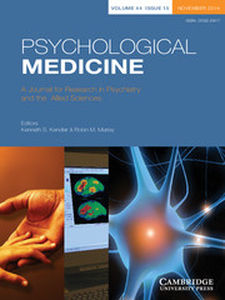Review Article
Collateral outcomes in e-mental health: a systematic review of the evidence for added benefits of computerized cognitive behavior therapy interventions for mental health
-
- Published online by Cambridge University Press:
- 19 February 2014, pp. 3137-3150
-
- Article
- Export citation
Original Articles
Integrating fragmented evidence by network meta-analysis: relative effectiveness of psychological interventions for adults with post-traumatic stress disorder
-
- Published online by Cambridge University Press:
- 16 April 2014, pp. 3151-3164
-
- Article
- Export citation
Longitudinal epigenetic variation of DNA methyltransferase genes is associated with vulnerability to post-traumatic stress disorder
-
- Published online by Cambridge University Press:
- 25 April 2014, pp. 3165-3179
-
- Article
- Export citation
Environmental transmission of violent criminal behavior in siblings: a Swedish national study
-
- Published online by Cambridge University Press:
- 28 April 2014, pp. 3181-3187
-
- Article
- Export citation
Mechanisms underpinning inattention and hyperactivity: neurocognitive support for ADHD dimensionality
-
- Published online by Cambridge University Press:
- 25 April 2014, pp. 3189-3201
-
- Article
- Export citation
Cortical thickness and inattention/hyperactivity symptoms in young children: a population-based study
-
- Published online by Cambridge University Press:
- 14 July 2014, pp. 3203-3213
-
- Article
- Export citation
‘Reading the Mind in the Eyes’: an fMRI study of adolescents with autism and their siblings
-
- Published online by Cambridge University Press:
- 26 February 2014, pp. 3215-3227
-
- Article
- Export citation
A population-based longitudinal study of childhood neurodevelopmental disorders, IQ and subsequent risk of psychotic experiences in adolescence
-
- Published online by Cambridge University Press:
- 25 April 2014, pp. 3229-3238
-
- Article
- Export citation
Cognitive variability in psychotic disorders: a cross-diagnostic cluster analysis
-
- Published online by Cambridge University Press:
- 07 April 2014, pp. 3239-3248
-
- Article
- Export citation
Prenatal maternal immune disruption and sex-dependent risk for psychoses
-
- Published online by Cambridge University Press:
- 26 March 2014, pp. 3249-3261
-
- Article
- Export citation
Evidence for structural and functional abnormality in the subgenual anterior cingulate cortex in major depressive disorder
-
- Published online by Cambridge University Press:
- 07 April 2014, pp. 3263-3273
-
- Article
- Export citation
Subtypes of major depression: latent class analysis in depressed Han Chinese women
-
- Published online by Cambridge University Press:
- 09 April 2014, pp. 3275-3288
-
- Article
- Export citation
The effects of co-morbidity in defining major depression subtypes associated with long-term course and severity
-
- Published online by Cambridge University Press:
- 17 July 2014, pp. 3289-3302
-
- Article
- Export citation
Dimensionality and stages of severity of DSM-5 criteria in an international sample of alcohol-consuming individuals
-
- Published online by Cambridge University Press:
- 25 April 2014, pp. 3303-3314
-
- Article
- Export citation
Protein kinase B (AKT1) genotype mediates sensitivity to cannabis-induced impairments in psychomotor control
-
- Published online by Cambridge University Press:
- 29 April 2014, pp. 3315-3328
-
- Article
- Export citation
Impact of stress on different components of impulsivity in borderline personality disorder
-
- Published online by Cambridge University Press:
- 06 March 2014, pp. 3329-3340
-
- Article
- Export citation
Abnormal resting-state connectivity of motor and cognitive networks in early manifest Huntington's disease
-
- Published online by Cambridge University Press:
- 27 March 2014, pp. 3341-3356
-
- Article
- Export citation
Correspondence
Letter to the Editor
-
- Published online by Cambridge University Press:
- 29 August 2014, pp. 3357-3358
-
- Article
-
- You have access
- HTML
- Export citation
A rejoinder from Gerger and colleagues
-
- Published online by Cambridge University Press:
- 05 September 2014, pp. 3358-3361
-
- Article
-
- You have access
- HTML
- Export citation
Front Cover (OFC, IFC) and matter
PSM volume 44 issue 15 Cover and Front matter
-
- Published online by Cambridge University Press:
- 29 September 2014, pp. f1-f2
-
- Article
-
- You have access
- Export citation



